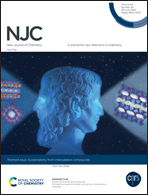Chemical transformation of a luminescent two-dimensional Eu(iii) coordination polymer in the aqueous phase†
Abstract
In this work, the 2D Eu(III) coordination polymer {[Eu(HPDC)(PDC)]}n (PDC = 2,6-pyridinedicarboxylate) (1) was prepared in a fast manner via microwave-assisted hydrothermal synthesis. The same compound was obtained by a conventional hydrothermal route and had its structure determined through single crystal X-ray diffraction. In 1, the HPDC and PDC ligands exhibit terminal and chelating bridging modes, respectively, forming a coordination polymer through interconnected europium–carboxylate chains, leading to a highly ordered two-dimensional layer. The nanosheets in 1 self-organize in the solid-state by intermolecular interactions, producing a 3D supramolecular network. Solid-state photoluminescence studies have shown that the antenna effect is responsible for the red emission of the compound under ultraviolet excitation. In alcoholic solutions, it was possible to exfoliate the material by ultrasonication in a top-down approach, leading to single nanosheets of 1. In the chemical stability studies, there was observed a water-induced transformation of 1, leading to the compound {[Eu(PDC)(HPDC)(H2O)2]·4H2O}n (2). The aqueous suspension of this material shows strong red luminescence with the naked-eye. 2 demonstrates reversible behavior induced by heating under reduced pressure. Our work highlights the properties related to solvent-induced exfoliation and water-induced transformation.

- This article is part of the themed collection: Sustainability from intercalation compounds


 Please wait while we load your content...
Please wait while we load your content...